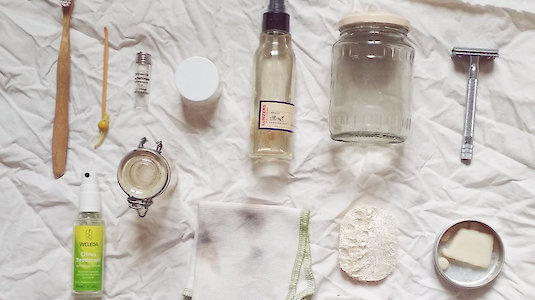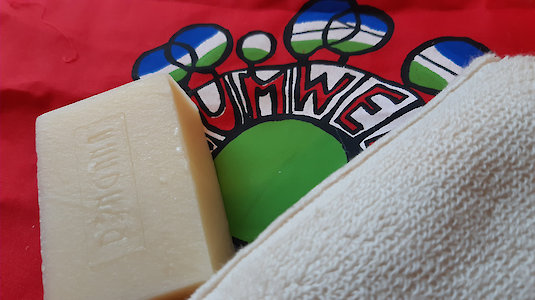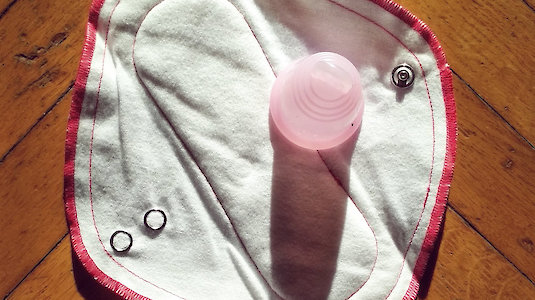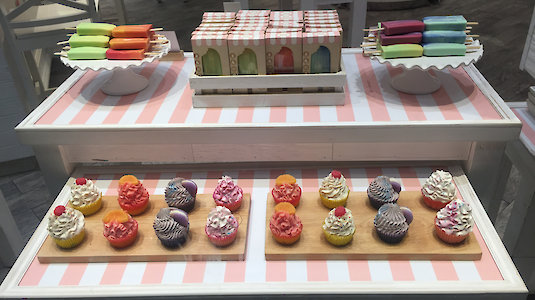Sustainable body care - plastic-free, organic and vegan?
Sustainable cosmetics are not that easy to find or you have to make them yourself in a complicated way. Both are stereotypes that you come across again and again. Podcaster and trainer Elena Beringer has done some research for us.
First of all, what is sustainable cosmetics? The term itself is not protected, just like the term natural cosmetics. However, some characteristics come to mind - plastic-free or even zero waste, vegan, animal-free, organic ingredients and fair working conditions. Basically, one can also say that the most sustainable cosmetics are those that we don't need in the first place. Many products are marketed to us through advertising as absolutely necessary, but no one really needs five different red lipsticks, three shower gels or different soaps for men and women. Reduction to the bare essentials is already a big step towards sustainability.

Unpackaged products
Some cosmetics are quite sensible and are probably used by most people. In the meantime, sustainable and ecologically produced cosmetics in minimal packaging are even available in drugstores, where previously they were often only found in health food shops or unpackaged shops. You can look out for paper, metal or glass packaging, ideally including a deposit option. It also makes sense to use solid products instead of the liquid variety, because they require less packaging, less water in production and also weigh less during transport. They often last longer, too. Good old solid soap as a multifunctional wonder for washing hands, shaving and showering, solid hair shampoo, deodorant, conditioner or toothbrush tabs are just a few examples. Make-up, such as rouge or eye shadow, is also available in solid and also refillable variants; likewise sun cream, which you should generally not make yourself.
Likewise, similar to ecological cleaning products, many products, such as liquid hand soap (if you don't want to do without it) are available in unpacked or some drugstores for refilling, even in their own containers. This saves packaging and you can also determine the amount you need yourself. Products like reusable make-up removal pads, cotton buds (e.g. at LastSwab), recyclable toothbrushes or stainless steel razors (e.g. at fairschenkt) are also great. Further tips can also be found here, for example.

Without microplastics
If you still want to buy products instead of making them yourself, it is advisable to pay attention to the ingredients and especially to avoid microplastics and harmful ingredients. , bei der man den Barcode der Produkte scannen und auf bedenkliche Inhalte checken kann. The Codecheck app, for example, helps here by allowing you to scan the barcode of the products and check for questionable contents. Cosmetic products with the Ecolabel are also free of microplastics and hazardous ingredients. Many people are also interested in whether the products are vegan and have been produced without animal testing. Vegan does not always mean animal-free. The organisation Peta has compiled a list of animal-free companies.
Homemade
Another option for sustainable body care is, as already mentioned, DIY - do-it-yourself. Advantages of this are, for example, that you have control over the amount, type and origin of the ingredients and are not dependent on a shop having the desired product in stock. Particularly suitable for first DIY cosmetics are toothpaste, deodorant and body butter. For example, you can mix your own toothpaste from 2 tablespoons of coconut oil, 1 tablespoon of baking soda and about 10 drops of peppermint oil. You have to get used to the fact that the mixture does not foam. The fact that the feeling of use can differ from what you are used to is generally always true for sustainable product variants.

For a super fluffy body butter, melt equal parts of almond oil, coconut oil, cocoa butter and shea butter in a water bath (recipe from Trash is for Tossers). Let the mixture cool, put it in the fridge for about 30 min and then whip the mixture with a hand mixer until you get a whip-like consistency. You can find more numerous recipes for DIY cosmetics on the internet.
As a final point, I would like to mention sustainable menstrual hygiene, which is also important in connection with body care. Depending on the body and the preferences of the menstruating person, organic tampons in paper packaging, menstrual underwear, reusable pads and panty liners or a menstrual cup are recommended. A detailed article can be found here.
In summary, you can orientate yourself on the following points:
- Is the product really necessary or do I already have something similar at home?
- Is the product available in solid form, with less packaging and/or vegan and ecologically produced?
- Is the product available for refilling near me? Don't forget your own containers!
- Can I make it myself? Sustainable search engines (e.g. Ecosia) can help!
In conclusion: in the spirit of sustainability, switching to sustainable products should not make life more difficult. Discovering alternatives for common products can be a lot of fun, enriching and also bring you into exchange with your own environment. That's why I always recommend communicating with others. Because if you can't find a sustainable alternative for a product, someone else might have the solution.
Further recommendations
- Unpacked shops like Holis Markt, Sonnengrün or Now Wow (Wien)
- More unpacked shops can also be found here: https://www.zerowasteaustria.at/zero-waste-shops.html
- DIY workshops with impact.earthlings or Katharina Rührt
*All links and recommendations are unsolicited and unpaid*.
Author: DI Elena Beringer
Elena Beringer is an active trainer, facilitator and podcaster (Imagination Pdocast). She also publishees content on Instagram as @marolenas_stimme She also publishes content on Instagram as @marolenas_stimme on the topics of sustainability, feminism and zero waste. She studied environmental and bioresource management in her Bachelor's and Master's degrees.
